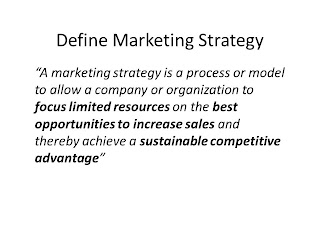Two weeks ago I was invited to give a refresher course on marketing to a group of entreprenuers, most of whom had little or no formal marketing training. While preparing my materials I came to a point where I had to touch on the concept of "Marketing Strategy". Below is the slide that spells out a formal definition of "Marketing Strategy".
Wow! That's quite a mouthful. I then thought, how could I explain this visually? It took a while but I then decided that I would use the idea of a battle to illustrate what the above definition of marketing strategy was trying to say. This is the first slide I used.
It show the battle formation of two opposing forces. The army on the left is outnumbered and outgunned but it has a single tank. The tank represents a competitive advantange. Based on the current formation, the army on the left has very little chance against the army on the right which has more resources at its' disposal.
However if the army on the left rearranges its' battle formation and focuses its strength i.e. the single tank that it has on a narrow front with the rest of the army providing close cover, the situation can take a totally different course.
The army on the left could effectively punch a hole into the defensive lines of the army on the right as shown below:
Once the defensive line is broken, the army on the left is then free to charge through and capture the flag and consequenly win the battle.
Instead of just elaborating on each keyword in the definition slide, tell a story around your explanation and make it as graphic as possible. In this example we have taken a very conceptual idea (that was potentially sleep inducing) and illustrated it in a dynamic and engaging way that was easy to understand.
Psychologists have done extensive research that suggests that people are better at remembering what they see rather what they hear. Use this to your advantage the next time you are presenting. This is just a simple example of how the use of simple graphics and images can help you to illustrate complex subject matter in a very short time. You could of course just verbalise an explanation of whatever you need to say.
However, you risk losing your audience which has a very short attention span. The human brain is wired to be as economical as possible and will try as far as possible to minimise its work load. We all have filters in the most basic parts of our brains that constantly scan all information we are receiving, if it looks or sounds like it will take a great deal of thinking to understand and does not threaten your well being in any way, the most common reaction is to shut off and disregard the information.
As far as possible try to weave a story around what you are trying to say. This helps to create a connection with the audience. People love to hear stories and most people love to tell them too. Unfortunately we often forget this when we are presenting.
Remember, always use pictures and images to support what you want to say. Also build a story around what you wish to say to keep the audience who have a short attention span engaged and on your side!







No comments:
Post a Comment